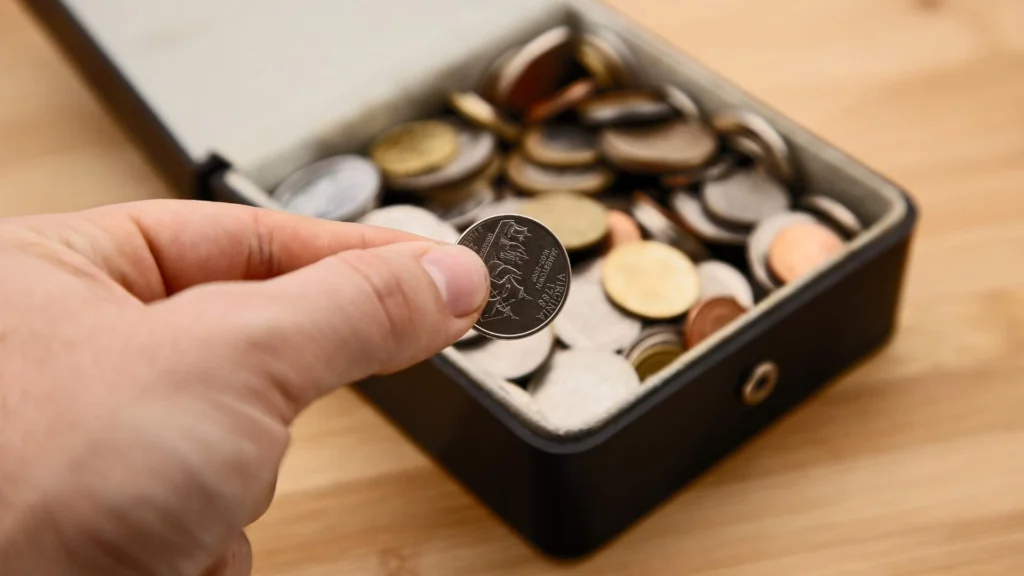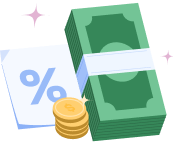Table of Contents
Why It’s Crucial to Teach Teens About Credit Early
If you’ve ever found yourself standing at the register while your teen excitedly waves their debit card for the first time, you know how quickly financial independence creeps up. The teen years are packed with milestones, including getting a first job, applying for college, and maybe even buying a car. However, one financial topic that’s too often overlooked is credit.
Teaching your teen about credit and being responsible while borrowing is one of the most impactful lessons you can give. This is because the habits they build now will echo throughout their adult life. Poor credit decisions like missing payments or maxing out cards can haunt someone for years, affecting everything from buying a home to getting a job.
One helpful ally in this journey is Beem – a financial tool that empowers teens to learn and track their credit before getting their first credit card. With real-time insights and educational resources, it helps teens build financial literacy step by step. Read on to explore how you can start teaching your teen about credit and borrowing before they learn the hard way.
The Basics of Credit: What Every Teen Should Know
When we talk to teens about credit, we have to meet them where they are. Start with simple definitions, like “What is credit?” and explain to them that credit is borrowing money with a promise to repay it later, often with interest. It’s a tool, not free money.
Why does it matter? A person’s credit score is like a financial report card. It tells lenders how trustworthy you are with money. A higher score means better chances at loans with lower interest rates.
Teens might not see why this matters yet, give them real-life examples like:
- Car Loan: A teen saving for a car might not have enough cash to purchase a car. Good credit can help them get an auto loan with a reasonable rate.
- Student Loan: Colleges often include private loan options, so better credit = lower rates.
Read related blog: Top 10 Remote Jobs for Teens That Pay Well
Teaching Teens the Importance of Responsible Borrowing
When teens realize they can “buy now and pay later,” borrowing becomes very tempting, but this can lead to serious consequences if not handled wisely. Teach them the following ways to be responsible while borrowing:
1. Borrowing Smart
Help your teen understand that borrowing isn’t about getting what you want now; it’s about being sure you can pay it back later. Please encourage them only to borrow what they know they can afford to repay. Go over the fine print together so they know exactly what they’re signing up for, including interest rates and due dates. Stress that missing a payment doesn’t just mean a late fee; it can hurt their credit and make future borrowing harder and more expensive.
2. A Missed Payment’s Ripple Effect
Imagine your teen forgets to pay a $200 credit card bill, with a 25% interest rate, and that balance quickly grows to $250. It might not seem like a big deal initially, but it adds up fast. Missing more payments can lead to a mountain of late fees, growing debt, and a damaged credit score. And that score affects everything from future loans to apartment rentals. It’s not just about one late payment—it’s about how quickly things can spiral if they’re not careful. One slip can cost way more than they expect.
3. The Role of Interest Rates
Interest rates are what lenders charge you for borrowing money. The higher the rate, the more you’ll pay back over time. For example, if you borrow $1,000 at 10% interest, you’ll owe $1,100, but at 25%, that jumps to $1,250. Teach your teen to compare interest rates before taking any loan or using a credit card, and to prioritize paying off high-interest debt first. Understanding how interest works helps them borrow smarter and avoid paying more than needed.
Tip: Make a visual chart comparing a low-interest vs. a high-interest loan. Teens are more likely to understand when they see how much money they’d have to pay back.
Read related blog: Why People Are Choosing Access Over Borrowing?
How to Teach Responsible Credit Card Use
At some point, your teen will likely be offered a credit card, often on a college campus with a free T-shirt; the temptation is real. That’s why teaching them what credit cards are crucial: short-term loans, not free cash. Here are ways you can teach them responsible credit card use:
1. Changing the Mindset
As you introduce credit cards to your teens, it is essential to challenge their view and tell them they aren’t free money and need to be paid back monthly. Their interest kicks in when balances aren’t paid in full. So, please encourage them to use credit only for what they can afford to pay off that month, avoiding impulse spending and checking balances regularly to keep track.
2. Set Up Automatic Payments
Let’s be honest: Teenagers have a lot on their minds, and it’s easy to forget a payment. That’s where automatic payments come in. Setting them up is a simple way to ensure that at least the minimum amount is paid on time each month, even if they forget. It’s a safety net that helps protect their credit score and avoids late fees. Pair that with Beem or any good budgeting app to send reminders or track due dates.
3. Credit Utilization
Another concept often overlooked is credit utilization. Teach them to use less than 30% of their total credit limit. If they have a $1,000 limit, they should stay under $300. Why does this happen? High utilization makes lenders nervous and can lower credit scores, even if payments are made on time.
Read related blog: How To Become Financially Free In Your Teens
Practical Steps for Teaching Teens About Credit
You don’t have to throw them into the deep end. Here are some practical, hands-on strategies.
1. Open a Joint Credit Card
Co-signing a credit card with your teen is a great way to teach responsible spending while still keeping an eye on things. Start with a low credit limit of around $300 or $500 to keep risks low. Make it a habit to review the monthly statements together, so they understand where their money’s going and how interest works.
Tip: Meet once a month for a “money date.” Review the statement, celebrate smart choices, and discuss areas for improvement.
2. Try a Secured or Prepaid Card First
Secured or prepaid cards are safer options if you’re hesitant to start with a real credit card. Teens can only spend what’s on the card, removing the risk of debt. Treat it like training wheels; it introduces credit principles, spending limits, and responsible repayment without real financial danger.
3. Talk About Building Credit Over Time
Teens may feel frustrated when their credit scores don’t improve right away. Remind them that building credit is a slow and steady process, more like building muscle or trust than flipping a switch. It takes consistent, responsible habits over time, like making on-time payments and keeping balances low. Encourage them to be patient and stay committed; the results will come, and their future self will thank them. Use Beem to track progress. Watching a score climb, even slowly, can be incredibly motivating.
Read related blog: Loans Like Kashable: Best Alternatives for Affordable Borrowing
Real-Life Example: How Sarah Built Credit at 18
Let’s bring this home with a real story.
Sarah was 18, had just graduated from high school, and landed her first part-time job. Her parents co-signed a student credit card with a $500 limit. At first, Sarah used the card for small things like gas, snacks, and occasional lunches. But soon, she started buying clothes and concert tickets. In her second month, she missed a payment. It wasn’t intentional—she just forgot—but that small slip cost her $35 in late fees, and her credit score took a dip.
Instead of scolding her, her mom sat down with her and showed her the consequences: how one late payment can linger on a credit report for up to seven years. They talked about setting up auto-pay and using reminders. They also set a spending cap of only 50% of the card’s limit at any time.
Fast-forward a year, and Sarah has never missed another payment. Her utilization stays below 30%, and she even starts using Beem to track her score and set savings goals.
When she applied for a car loan at 19, she had a good credit score and qualified for a lower interest rate than her peers.
Read related blog: High-Yield Savings Accounts for Kids and Teens: Teaching Smart Saving
Beem’s Tools for Tracking Credit and Financial Progress
Beem has a Budget Planner tool to help you manage your money wisely. This function allows you to analyze your income and expenses, establish spending restrictions, and locate savings opportunities to keep your finances on track while boosting your credit score. Your BFF – Better Financial Feed™ will alert you to potential overdrafts, costs, and revenue made, helping you better understand your money.
The platform provides free credit monitoring services, making them accessible to everyone. Unlike competitors that charge hidden or membership fees, Beem prioritizes openness and affordability. While the free service includes sophisticated features such as real-time notifications and extensive credit analytics, customers may upgrade to premium plans.
These advanced alternatives provide extra value to anyone seeking complete credit monitoring and protection. Beem’s Everdraft™ allows for better financial management and avoiding overdraft penalties, perhaps improving credit. Making on-time payments and avoiding financial shortages may increase your total credit score.
FAQs on Teens and Responsible Credit
When should my teen get their first credit card?
The best time for your teen to get their first credit card is around age 18, when they can start building credit in their name. They typically earn some income and are ready for more financial responsibility at this age. It’s essential to ensure they understand how credit works first, how to pay on time, manage spending, and avoid interest charges.
How can I help my teen build a good credit score?
Helping your teen build a good credit score starts with the right tools and habits. You can co-sign a credit card with them or start with a secured card to limit risk. Teach them to pay bills on time and keep their credit utilization low, ideally under 30% of their limit. Reviewing statements and setting up automatic payments can help them stay on track.
What’s the best way to explain credit to my teen?
Credit can be confusing, so using a simple analogy helps. Try comparing it to borrowing a library book. You’re trusted to return it on time, and doing so earns trust for future checkouts. Similarly, using credit means borrowing money with a promise to repay it. When your teen pays it back on time, they build trust with lenders. Keep the conversation relatable and real-life focused so they see credit as a helpful tool, not free money.
Should my teen have access to a high-limit credit card?
Teens should start with a low-limit credit card, around $300 to $500. This gives them a safe space to learn about budgeting and managing payments without the temptation to overspend. A high-limit card can feel like free money and may lead to debt if you’re not disciplined. Starting small helps them build credit gradually and gain confidence.
How can my teen check their credit score?
Your teen can easily check their credit score using apps or financial tools like Beem, which provide regular updates and tips for improving their financial habits. Please encourage them to check it monthly to track progress, celebrate improvements, and spot any issues early. It’s a great way to stay motivated and build healthy credit habits.
Empowering Teens to Make Smart Financial Choices
Teaching teens about credit and responsible borrowing is one of the most valuable life skills you can pass on. Starting around age 18, with the proper guidance, they can build healthy financial habits like paying on time, keeping credit use low, and understanding how interest and credit scores work. Using tools like Beem can help them track progress and stay informed. Download the app now!
These lessons don’t have to be overwhelming; small, consistent steps make all the difference. Mistakes will happen, but they’re part of the learning process when approached with patience and support. Start with a joint or secured card, discuss real-world examples, and emphasize that credit is a tool, not free money. The earlier they learn, the more prepared they’ll be.
Empower your teen today with the knowledge to build a strong, responsible financial future, and they’ll thank you.
















































